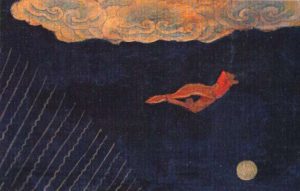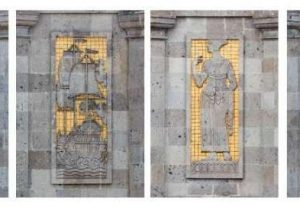
In August 2022, Licchavi House, an exciting new creative Dharma initiative of the revered Bhutanese lama, filmmaker, and author Dzongsar Jamyang Khyentse Rinpoche, held its ground-breaking ceremony the Buddhist enclave of Boudha on the outskirts of Kathmandu.
The high-profile celebration featured a host of colorful dance and musical performances by Bhumisparsha, a Dharma project of Siddhartha’s Intent India, as well as a performance of If We Don’t Act Like Gods Who Will, a play written by Rinpoche and offering a unique perspective on climate change and spirituality.*
Spearheaded by the Kathmandu-based Bhrikuti Devi Trust, a nonprofit organization that promotes the spiritual and cultural heritage of Himalayan regions and addresses social and humanitarian needs, the launch of Licchavi House represented a new and creative manifestation of the Buddhadharma founded specifically with the spiritual future and well-being of young people in mind.
Standing beneath the benevolent gaze of the venerable Boudhanath Stupa, Licchavi House is envisioned as an integrated hub for cultural heritage and the arts, dedicated to nurturing the study, discussion, and practice of Nepal’s ancient wisdom traditions, alongside art, film, photography, and other creative expressions. And while the campus of Licchavi House is still under construction, the project’s work in connecting with the young people of Nepal and other Himalayan communities is already well underway.
In the words of Dzongsar Khyentse Rinpoche:
First, we intend Licchavi House to represent the remarkable gift that Nepal itself can offer the world. While Nepalese have no choice but to adapt to this fast-paced 21st century, the country and its people still magically keep their ancient spiritual and cultural inheritance alive and vibrant. . . .
As Buddhism is deeply rooted in its history and culture, Nepal is the place renowned spiritual masters of all traditions have chosen as their seats, and a thousand years ago was the key junction through which some of the greatest Himalayan saints and scholars passed. To this day, this land remains the meeting point for some of Buddhism’s most important influences.
And of course, based on today’s borders, Nepal can proudly claim to be the birthplace of Prince Siddhartha and to be the nation that gave the Buddha Shakyamuni to the world. . . .
By nurturing the study, discussion and practice of Nepal’s ancient wisdom traditions alongside art, film, writing, photography, and other creative workshops, Licchavi House aims to celebrate this remarkable ancient heritage in ways entirely relevant to our modern world.
To that end, we want Licchavi House to be a place where young people in particular—girls and boys of all ages—and also ordinary folk from teachers to entrepreneurs to workers to students, feel comfortable just being who they are and enjoying each other’s company as they collectively learn about, practice, and take pride in their splendid inheritance.*

Seeking to better understand the underpinnings of this unique Dharmic undertaking, BDG sat down with Max Dipesh Khatri, a filmmaker and entrepreneur who is leading the effort to manifest Licchavi House, in Kathmandu to find out more.
BDG: Could you talk a little about Dzongsar Khyentse Rinpoche’s vision for Licchavi House?
Max Dipesh Khatri: I can’t help but wax a little poetic about this project. This activity is really an aspiration in the spirit of the bodhisattva of wisdom Manjushri from the standpoint of how we can find ways to really benefit the sentient beings of today.
If you look at the Khyentse lineage, you’ll notice that these teachers, besides being masters in the non-sectarian Rimé movement, were very ahead of their time—they were very good at making sure that the next generation had something in their hands that they could use as spiritual tools and from which they could benefit. And always sustaining the Buddhist ideal of expounding the Buddhadharma for the sake of all sentient beings.
So I think that, by the same token, Rinpoche, in seeing the new generation of young people—you know, what engages, what interests, what inspires, what moves this new generation of people—he has come up with this Buddhist arts center and chosen this very special location near the Boudhanath Stupa. And the whole idea is to let the youth come and explore aspects of their own creativity, their forms of expression, and while they’re doing that they’re also subtly engaging with aspect of the Buddhadharma.
As you know, all our events are charitable, undertaken with donations and with the motivation of helping people and receiving help from people. Helping is always involved at the beginning and the end of the process; either we’re receiving help or we’re trying to help somebody. So this alone brings a distinct element to the simple act of creating art.
And because the work we’re doing is around Boudha, and because it’s with the blessings of Rinpoche, there’ll be a lot of Buddhist teachers, rinpoches, khenpos, and scholars who’ll be willing to come to this venue and share. It’ll be a great place for such influences to merge and co-exist and inspire. Really, another approach for helping young people to engage with the Buddhadharma.
Of course, at the same time, we’re also presenting our rich heritage to them. This whole project is intended for the young people of Nepal and the young people of the Himalayan region. It represents a focal point for our artistic and cultural heritage that many of us may not even be aware of or educated about.
Rinpoche really understands that art is one place that can help to engage with kids who are caught up in the intense distractions of the modern world. And grounding them in art is the first step—bringing them back to art and to living in the present moment. And then, I think, if the causes and conditions align, and if there is merit, then maybe wisdom will arise and people may benefit.

BDG: I had the good fortune of speaking briefly with Rinpoche in 2022, and he emphasized his concern for young people and their connection with the Buddhadharma.
MDK: What Rinpoche is giving us here is a kind of medicine; a true therapy for the benefit of sentient beings. Rinpoche knows this—he is an embodiment of Manjushri—although he is not at all modern; if anyone says that Rinpoche is modern, that person doesn’t know what Rinpoche is!
He is a living teacher, like the Buddha. When Shakyamuni Buddha came and taught 2,600 years ago, he gave teachings to the people of that time in accordance with their circumstances. He was giving the same timeless teachings, but the methods that he used, the tools that he used were skillful means suited to the people of that time.
In the same way, our children, my brothers and sisters, are ensnared by digital technology and media and fashion and a thousand other things. Rinpoche is trying to use the creative outlets of this project as an avenue to bring them back to their true nature.
And I think that Rinpoche trusts that art is a very simple, straightforward means that will engage with and connect with the minds and hearts of all these young people.
BDG: What sort of things have been planned in the interim since the groundbreaking ceremony and the imminent opening?
MDK: Well, without wishing to say too much at this formative stage, we’re looking to have an opening in the near future—very very soon!
Rinpoche has emphasized that the building itself is not the most important aspect of Licchavi House; it’s what we do there, the events and how we engage with the young people. The center is just the means, the vessel. And so the focus is on activities, events, engagement; people touching each other with the Dharma.
Rinpoche gave us clear instructions about a year ago when we began with the groundbreaking ceremony and cultural events. There was also a teaching associated with it. Rinpoche very kindly and very generously gives his precious time. We’ve had a second major event since then, as well as smaller art events that we hold for the local children. We’re now planning another major event, hopefully for next spring with Rinpoche, combining art and Dharma teachings.
So until we do formally open, we’ll maintain our practice of holding events and art activities, and hopefully grow and progress in this way.

BDG: What facilities are planned for Licchavi House when it opens? How should people best understand its role and function?
MDK: Well, it’s primarily an arts center—a global arts center—so that will be the heart of it. But in order to help support the center’s activities, we’ll have ancillary facilities and resources. For example, there’ll be a small sort of boutique retreat center and residence interlocking with the exhibition gallery and the main shrine area, and with a restaurant downstairs. There will also be an auditorium for teachings, pujas, education, movie screenings, dance and theater performances, and so on. On the third floor, there’ll be a co-working space and library for young artists to engage, and on the fourth floor we’ll have be a rehearsal space and yoga studio, and a digital audio-visual studio.
But it’s important to remember that this is not a business or a money-making venture; it’s more like a non-commercial support system for young people who can’t afford to go to an expensive café or studio to discuss or develop their art or meet like-minded people.
Nepal is such a melting pot for people from all across the world, and the culture is so open and welcoming, so we expect as much as 40 per cent of the people using the center and running programs at the center to come from outside of Nepa—students and scholars from China, India, the West, and so on. So we anticipate that Licchavi House will have a very contemporary and global flavor.
From talking with Rinpoche about Licchavi House, it’s very clear that this is about empowering the local people. Nepal is the place that gave the Buddha to the world, and Rinpoche is really trying to bring that back home to the people. The young people also need to connect with the true nature of what is means to be from Nepal and to have a spiritual heritage that has inspired millions across the world to this very day. And here we’re so close to it.
And so we want to keep that spiritual aspiration in focus, and enable young people to take the reins on this, to take ownership of their heritage, to enjoy it and share it with their peers and with the whole world.
See more
Licchavi House | Kathmandu
Licchavi House (Instagram)
Licchavi House (Facebook)
Siddhartha’s Intent
Khyentse.org
Related features from BDG
Clearing the Path to Compassion: A Conversation with Chökyi Nyima Rinpoche
Bodhicitta and the Buddhadharma: An Interview with His Holiness the 41st Sakya Trizin
Journey to the Buddha’s Homeland: Rediscovering Pilgrimage Sites in Nepal
One Year On: Restoring Quake-damaged Heritage Sites in Nepal
Related news reports from BDG
Sahaja: Siddhartha’s Intent Announces Buddhist-Inspired Art Show in Bodh Gaya
Private: Lumbini Development Trust Partners with Singapore-based Organizations to Safeguard Ramagrama Stupa in Nepal
Tergar Institute in Nepal Welcomes Inaugural Cohort of Buddhist Students
His Holiness the 41st Sakya Trizin Visits Nepal for the First Time Almost a Decade
Nepal Inaugurates Newly Restored Fifth-Century Buddhist Monument near Kathmandu
108 Korean Buddhist Monastics Embark on 1,200-km Pilgrimage in India, Nepal


















